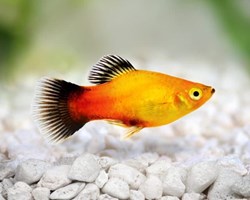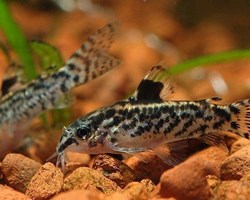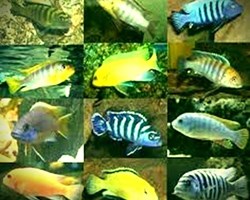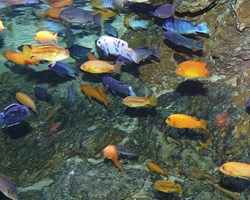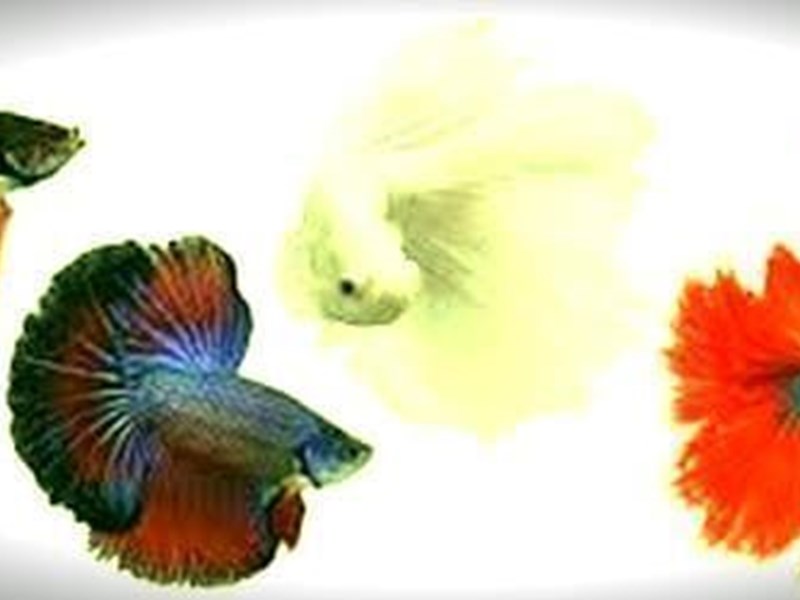
WE TAKE CARE OF YOUR PETS, WE TAKE CARE OF YOU.
At Glu Glu Pet we take care of our animals as well as possible, we know all their characteristics and we give them the best care because our motto is: "healthy pets, happy pets".
It is very important to know the characteristics of our pets to give them the best care, for this we have to know where they live and what their habitat is, to always provide them with the best care.
To learn more about these fish, consult another of our articles: The Siamese fighting fish, Betta Splendens.
HOW BETTA FISH LIVE:
Native to the Mekong Basin in Southeast Asia, Betta fish generally thrive in slow-moving water such as small streams, ponds, and rice paddies.
Some species are usually raised by the peasants of the rice fields to consume them later.
It is very common in regions of Thailand, Vietnam, China and Siam.
They adapt to rare situations, such as aqueous media with acidic pH and hardness, and the temperature does not pose any problem, being between 24 and 30 degrees.
They are usually surrounded by vegetation, so they can also use oxygen to stay alive.
Betta are beautiful fish with different tail shapes that make them really fascinating.
They can be in the form of a comb, crown, half moon, half sun, delta, double feather, pink, round and veil.
Betta fish are easy to care for and just about anyone could do it by changing their water and feeding them regularly.
But these fish need something else to live happy and healthy.
In their habitat they are fish that have somewhat opaque colors although this varies when they get nervous.
But this fish has been crossed to achieve vibrant colors such as reds, blues or greens.
It is a species that has become a very popular fish for aquariums, due in part to its colors and also to its elaborate fins, because they are very showy, in the form of long veils.
However, you should keep in mind that despite their calm nature, they are quite aggressive fish.
In Glu GLu Pet you will see that they are in small cubicles, which seem to be to protect them from the other fish, but in reality they are to protect the other fish from them.
They are very territorial and that is where the name Siam Fighter comes from, and in the case of male bettas they can attack other fish of the same species causing serious injuries and even death.
The females of this species can live together, and the males can coexist with fish of other species without problem.
Males can be easily distinguished from females, as males are larger, their colors are brighter, and their fins are more ornate.
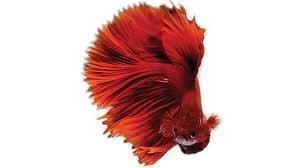

HOW IS THE BETTA FISH:
When they grow, they can reach up to six centimeters in length.
Females generally tend to be larger than males, however, their fins do not develop as much and their color is usually somewhat darker.
There are many types and their colors are variable.
There are red, green, blue and crossed colors, finding these three shades in the same specimen.
If you want to get a specific color you have to cross two fish that are the same color.
The dorsal and anal fins are highly developed, not so much the caudal fin.
To differentiate the sex of these fish, it will suffice to know that the males have greater development of their fins than the female specimens.
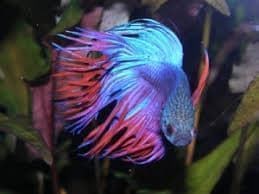
HOW THEY BEHAVE:
Being very territorial, it is almost impossible to keep two males in the same space because they can kill each other.
After a rigorous dance in which both fish challenge each other to swim, they extend their tails and lunge at each other, destroying their fins and causing severe injuries that lead to death.
The females are usually more peaceful, and that is why it is recommended to have three females for each male.
The coexistence of fish grouped in this way does not usually pose a problem.
As for their life expectancy, they usually live about three years, no more.
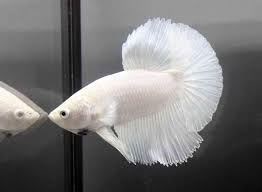
THE CHARACTERISTICS OF THE BETTA FISH HABITAT:
In their natural habitat they are omnivores, they eat all kinds of insects that are within their reach such as flies, grasshoppers, crickets or the larvae of any insect that they can find on the surface of the water.
In their habitat they have dull brown or green colors, and they are more showy with smaller fins.
The betta fish that we know from aquariums has undergone several crosses to achieve such a spectacular result in colors, tail shapes and sizes.
They have a special organ called a labyrinth that allows them to breathe air from the surface.
This labyrinthine organ is due to the fact that in their habitat they can find waters with little oxygen content such as shallower rice fields, and they could even live in stagnant or polluted waters.
When the female betta lays her eggs, the male picks them up with his mouth and spits them out into a bubble nest he has previously built, and takes care of the eggs until they hatch.
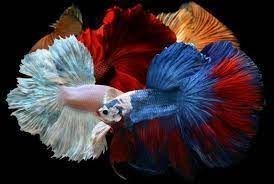
AQUARIUM CARE FOR BETTA FISH:
To ensure that a Betta fish enjoys a good quality of life, we must try to offer it an environment similar to the one it would have in the wild.
The Betta fish is native to Thailand and its habitat is shallow water, such as rice fields.
They go out with some regularity to take in the air, for that reason you will not need to add a filter or an aeration system.
The most important thing is that the Betta fish has a spacious and clean habitat, adapted to its specific needs as a species.
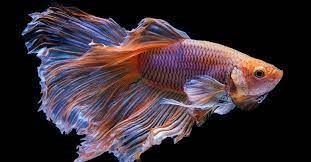
BETTA FISH AQUARIUM ELEMENTS:
It is very important that the Betta fish tank contains various elements, for that reason below, in Glu Glu Pet we will mention those that are essential.
Do not forget that you can choose those that you like the most so that your fish tank is unique:
- Sand or gravel: those with a soft and fine texture are preferable so that they do not bother our Betta fish's fins. In addition, it must have a minimum thickness of at least 2 centimeters.
- Plants: we will always use those that are natural to avoid tears in the tail of our fish. We recommend the Elodea densa, the Duckweed, the Sword of the Amazon or the Bamboo. You will be surprised how good it can be.
- Rocks: We will try to minimize the use of rocks and other elements that can damage the fins of our betta fish. With two or three elements of this type it will be enough. In Glu Glu Pet you will find all kinds of elements, from small pirate ships to Buddhas or dragons, however, we advise you to look for those with rounded edges and smooth textures.
- Lighting: a trick to beautify the environment of our fish tank is to include LED lighting elements for fish tanks, available. Use a shade of blue, green or lilac to highlight the decoration or color of your betta fish.
- Hideout: especially if you use lighting or if you have several copies of Betta fish, it is essential that you create hiding places of all kinds inside the fish tank. You can bury bowls, make a nest with plants, coconuts, logs, castles...
Maintenance, temperature and extra tips. - The temperature of the fish tank should range between 22ºC and 32ºC: for this reason, if these temperatures do not exist in your area, you should purchase an aquarium air conditioner that ensures the ideal temperature for this species. At Glu GLu Pet we also advise you to use water without chlorine and without lime, which you will renew every 7 days, removing three fingers from the water to avoid a radical change in the environment that affects the health of the Betta fish.
It is essential that we regularly supervise our Betta fish to check that it is physically well and that it has not suffered injuries due to the elements included in the fish tank, as well as those that may be caused by other fish.
In addition, it is highly recommended that the tank be covered at the top, since it is a fish with a tendency to jump, which can cause it to leave its habitat.
BETTA FISH COMPATIBILITY:
A factor that will have a direct impact on the care of the Betta fish, is the diet and in the tank is the presence of other animals in the aquarium, we will talk about other Betta fish, different species and even cleaning molluscs or aquarium shrimp.
- Betteras: they are specific environments for the breeding of betta fish. They are small and reduced in size, for this reason their use is exclusive during the breeding season.
- Several females: you can gather several females in the same tank, although there must be at least three, so that they establish a hierarchy. Although it is less likely than in the case of males, females may attack each other, in this case you will need to have an extra tank to be able to separate them. To improve the chances of coexistence, you must adopt different females (sisters) that have lived together since they were little at the same time. Use a minimum 30 or 40 liter aquarium.
- A single male and three females: in this case you must be careful with the aggressions that the females may have against each other, follow the advice that we discussed in the previous point. Use a 40-liter aquarium to avoid attacks as well as provide them with different hiding places in case they need to take refuge.
- Betta fish community: we remind you at Glu Glu Pet that the Betta fish or Siamese fighter is an aggressive fish by nature, for that reason and unless you have an aquarium of at least 100 liters full of hiding places, we do not recommend creating a community.
- Community of different fish: you should educate yourself about the different types of cold water fish before putting them together to prevent attacks and aggressions. It is important that the fish tank has a capacity of at least 100 liters and that it has various hiding places. Pearl gouramis are a good choice.
- Finally, remember that you should never bring two or more males together: they are very aggressive with each other and would end up hurting each other. The most advisable thing is to have a single specimen in the fish tank, however, you can find out about the most compatible species with the Betta fish.
THE IDEAL COMPLEMENTS OF THE BETTA FISH:
For the daily care of our aquarium we may need different accessories and complements that help us achieve the perfect environment for our fish.
A betta fish can live up to three years with good care.
Some tips to achieve a happy environment for betta fish are:
- It should be in a wide space, with at least 24 square inches of water for each inch of fish.
- The water pump and filter are quiet and keep the water clean and flowing constantly.
- The water should be at a temperature between 22 and 27 degrees Celsius.
- Place an air pump to keep the water with oxygen and a thermometer to control the temperature.
- It is important that the fish can explore, so you must put plants, rocks and different objects so that it can do so.
- You must provide a place for it to hide, since although they like to swim, they love to be among the foliage of the aquarium, and that is where they will spend more time.
- Place your aquarium away from the television and out of direct sunlight. They must be in a quiet area.
- Try not to scare the fish with sudden changes in lighting or noise.
- Feed them at least once a day and with proper food.
- Regularly clean the aquarium.
- Make sure you always use an aquarium with a lid as these fish jump and can fall out of the tank without you knowing.
TYPES OF BETTA FISH:
There are different types of betta fish that we can identify through their morphology.
Basically, we can orient ourselves through the fins and the tail.
But in addition, in this way, we can also learn to differentiate a male betta fish from a female.
1. Veil tail betta fish:
The betta splendens veil tail fish is undoubtedly one of the most common varieties that exist and stands out for its veil-shaped tail fin, as its name indicates. The tail should be the same size as the body and the base and tip should be equally wide.
2. Halfmoon Betta Fish (Halfmoon betta):
The half-moon tail betta fish is one of the most attractive and appreciated for its large rounded tail that sometimes exceeds 180º.
It is voluptuous and we can find it in many different colors. The female shows a short but equally rounded tail.
3. Crown Betta Fish:
The crown tail betta splendens is also one of the most appreciated betta fish for its peculiar fin that extends beyond the tail forming tips similar to those of a crown.
This betta fish is the result of an intense controlled selection.
The male is the one who shows the largest and most elegant crown, the female will simply show some small characteristic points.
4. Double tail Betta fish:
The double tail betta fish does not actually have a double tail, it is a single caudal fin that divides its bones in two, one above the other, creating a beautiful figure unlike all other betta fish.
The female also shows this type of genetics although less showy.
HOW THEY FEED:
Betta fish can be both herbivorous and omnivorous.
They are capable of feeding on mosquitoes, larvae, worms or zooplankton.
The presence of varied meat products in their diet has a direct impact on the pigmentation of their skin, reaching more vivid and beautiful shades.
The Betta fish feed must be adapted to its nutritional needs and it will directly influence its scales and life expectancy.
We are talking about a fish that in the wild feeds on small insects that reside among plants or at the bottom of rivers and, although it is an omnivorous fish, the Betta fish prefers to feed as if it were a carnivore.
- Flakes (or pellets): this food is available in any specialized store and is a daily extra to ensure adequate nutritional intake, however, it should not be the basis of your diet.
- Crustaceans and insects: you must offer a varied amount of food of animal origin, which you can buy in specialized stores, either live or frozen. You can include mosquito larvae, tubiflex worms, grindal, brine shrimp etc.
- Assorted vegetables: you can also enrich their diet by making small "bouquets" of assorted vegetables, such as the tender shoots in salads. You can also bet on zooplankton.
- Betta fish porridge: Some people prefer to make a porridge by proportionally mixing all the food, including 60% animal food and 40% flakes and assorted vegetables.
HOW THEY REPRODUCE:
At the time of reproducing they have a ceremony worth contemplating.
When two Betta fish mate, they usually accompany the ritual with a beautiful dance, which finally culminates in the creation of a bubble nest where they incubate the new offspring, this nest is formed through the mucosa secreted by the male betta fish, so that the eggs are protected until they hatch.
So that they can reproduce in captivity, it is preferable to keep them away from the rest of the fish and that they are surrounded by a lot of vegetation, with a smooth floor without gravel because the eggs have a similar color and could become confused.
The temperature should remain above 26 to 28 degrees.
The water must have a low presence of nitrites and be kept as calm as possible.
It is also recommended to remove the female after laying, as the male will watch over the rest of the reproduction process.
MORE BETTA FISH CARE:
The life expectancy of the Betta fish is around 5 years, for this reason, if you want your fish to reach it, you must pay special attention to its care and offer it the best possible quality of life.
Do not forget that it will also be important to know the most common diseases of the Betta fish, in order to be able to identify them and treat them if they appear.
MOST COMMON DISEASES OF BETTA FISH:
The betta or also called "combatants" are those small fish with a lot of personality, that many people want to have, due to their vibrant and beautiful colors.
If the aquarium or fish tank where they are kept in the best conditions: clean and fresh, the betta can live longer and be happier.
If the space is not suitable for healthy living, bettas often generate parasitic, fungal or bacterial diseases.
GET TO KNOW A LITTLE MORE ABOUT YOUR BETTA FISH:
Most of the diseases that betta fish suffer can be prevented only with a good and clean environment.
Try to start getting to know your fish from the first day you bring it home.
Observe his behavior when he is in optimal conditions, in this way, if he gets sick and the physical symptoms have not arrived, you will be able to identify if something is not right since, surely, his behavior will change.
A good time to do this is during aquarium cleaning and when feeding.
If your fish is sick, it won't want to eat as much or will refuse to eat at all.
COLUMNARIS- MOUTH FUNGUS:
The mouth fungus is a bacterium that, by itself, is gestated in aquariums and ponds.
It is a bacterium that can be both beneficial and harmful.
When a betta suffers from this disease, physically, it begins to present "cotton or gauze" type spots on the gills, mouth and fins throughout the body.
This problem is caused when the conditions of the animal's habitat are not appropriate or stressful and there is little circulation of new and clean water.
THE HODROPESY:
It is not considered a disease as such, but rather a manifestation of the poor internal or degenerative state of the fish, present due to other pathologies such as, for example, swelling and accumulation of fluid in the liver and kidney.
It can be caused by parasites, viruses, poor nutrition, and bacteria.
Dropsy is serious and visible because the abdominal area is clearly swollen and some parts of the body appear as if the skin is made of little pine trees.
Other symptoms are poor appetite and the constant need to rise to the surface to receive oxygen.
It is a disease that could be contagious to other members of the aquarium, but in most cases it is not.
BROKEN OR FRAYED TAIL:
This is, without a doubt, one of the most common diseases of betta fish, with hundreds of cases reporting its appearance.
Its long, technicolor-style fins are susceptible to poor water quality, though it appears as if the betta is biting its own tail due to boredom or stress.
In addition to the drastic change in the state of the tail, which is clearly torn, the animal may show decay, strange white spots, black and red borders along the affected area.
Don't worry because with a treatment, based practically on changing the water daily and checking the source of it, your betta's tail will grow back.
Don't let the symptoms progress, as the rot could eat away at other skin tissue and turn a treatable problem into a deadly disease.
ICH OR WHITE SPOT DISEASE:
Extremely common, caused by the presence of a parasite that the betta's body needs to stay alive.
Its symptoms begin by changing the behavior of the animal.
Your fish will be very subdued, sometimes nervous, and rub their body against the walls of the aquarium.
It is later when the white dots appear all over the body.
These points are nothing more than cysts that act as a wrapper for parasites.
If the disease is not treated, the fish could die of suffocation because, due to so much anxiety, the heart rhythm is altered.
Salt water baths, drugs and even thermotherapy are some of the treatments.
SEPTICEMIA:
Septicemia is a non-contagious disease caused by bacteria and derived from stress caused by factors such as: overcrowding, sudden changes in water temperature, the arrival of new fish in the aquarium, poor food conditions or injuries of any kind.
It is diagnosed by the presence of red blood-like markings all over the betta's body.
The most typical treatments for this disease is the placement of antibiotics in the water, which can then be absorbed by the fish.
Similarly, antibiotics should be used sparingly.
It is best to ask the veterinarian before the application, so that he can recommend the most appropriate dose.
Other articles that may interest you:

